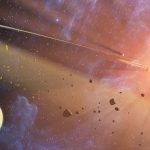Key Takeaways:
- A researcher has pinpointed the impact crater of its rocket booster on the Moon using high-resolution images from NASA’s Lunar Reconnaissance Orbiter (LRO).
- Despite losing tracking data for the booster prior to impact, physicist Jeff Plescia identified the Apollo 16 booster’s impact crater, shedding light on its exact location.
- The Apollo 16 mission, which marked the fifth human landing on the Moon, conducted experiments involving crashing their Saturn V stage 3 booster onto the Moon’s surface to perform seismic measurements.
- Recent discoveries using the LRO reveal insights into lunar surface activity, such as gravitational forces causing cracks and potential moonquakes, though the absence of a seismic sensor network limits hypothesis testing.
- NASA’s ongoing exploration ventures include plans for Mars missions, with upcoming astronaut applications indicating an inclusive approach with no age limit.
Nearly half a century after the Apollo 16 mission, a significant breakthrough has occurred in lunar exploration. A dedicated researcher has accomplished the monumental task of identifying the precise location where the mission’s rocket booster crashed into the Moon. The successful pinpointing of this impact crater comes after speculation and uncertainty regarding the final resting place of the Apollo 16 booster.
The Apollo 16 mission, a pivotal NASA expedition that secured the fifth successful human landing on the Moon, aimed to facilitate scientific experiments even after the mission’s completion. As part of these endeavors, the crew intentionally directed their Saturn V stage 3 booster to collide with the lunar surface post-completion of its primary task—safely escorting them into lunar orbit.
Regrettably, technical complications resulted in the loss of crucial tracking data for the rocket, leaving a persistent void regarding the precise crash site. However, Jeff Plescia, a physicist affiliated with Johns Hopkins University, emerged as a guiding force in resolving this mystery.
Leveraging high-resolution images produced by the LROC system aboard NASA’s Lunar Reconnaissance Orbiter, Plescia adeptly navigated through the lunar terrain to unearth the elusive impact crater.
Comprising astronauts John Young, Thomas Mattingly II, and Charles Duke, Jr., the Apollo 16 mission encapsulated both triumph and scientific exploration. Departing from Florida in April 1972, the mission’s lunar module, Orion, landed in the Descartes Highlands of the Moon—a monumental step in human exploration and lunar research.
Advancements in lunar exploration, propelled by tools like the Lunar Reconnaissance Orbiter, have expanded our knowledge of the Moon’s geological dynamics. Recent revelations suggest that Earth’s gravitational influence contributes to fissures in the lunar surface, potentially triggering seismic activities known as moonquakes. Despite these findings, the absence of a comprehensive seismic sensor network hampers the verification of this hypothesis.
The remarkable endurance of human-made imprints on the Moon, visible even after four decades, underscores the enduring legacy of space exploration. The utilization of satellites like the LRO stands as a testament to humanity’s sustained interest and involvement in unraveling celestial mysteries.
Looking ahead, NASA’s trajectory in space exploration encompasses ambitious missions, notably the impending selection process for astronauts for future Mars missions. Notably, the absence of an age limit in these astronaut applications reflects a more inclusive approach, inviting individuals across generations to contribute to the next phase of space exploration.


